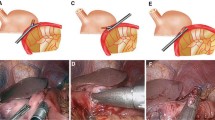Abstract
Background
Delta-shaped anastomosis is usually applied for an intracorporeal gastrogastrostomy in totally laparoscopic pylorus-preserving gastrectomy (TLPPG). However, the remnant stomach is slightly twisted around the anastomosis because it connects in side-to-side fashion. To realize an intracorporeal end-to-end gastrogastrostomy using an endoscopic linear stapler, we invented a novel method including a unique anastomotic technique.
Materials and methods
In this new approach, we first made small gastrotomies at the greater and lesser curvatures of the transected antrum and then pierced it using an endoscopic linear stapler. After the pierced antrum and the proximal remnant stomach were mechanically connected, the gastrotomies and stapling lines were transected using an endoscopic linear stapler, creating an intracorporeal end-to-end gastrogastrostomy. We have named this technique the “piercing method” because piercing the stomach is essential to its implementation. Between October 2015 and June 2017, 26 patients who had clinically early gastric cancer at the middle third of the stomach without clinical evidence of lymph node metastasis underwent TLPPG involving the novel method.
Results
The 26 patients successfully underwent an intracorporeal mechanical end-to-end gastrogastrostomy by the piercing method. The median operation time of the 26 patients was 272 min (range 209–357 min). With the exception of one gastric stasis, no problems associated with the piercing method were encountered during and after surgery.
Conclusion
The piercing method can safely create an intracorporeal mechanical end-to-end gastrogastrostomy in TLPPG. Piercing the stomach using an endoscopic linear stapler is a new technique for gastrointestinal anastomosis. This method should be considered if the surgical aim is creation of an intracorporeal end-to-end gastrogastrostomy in TLPPG.







Similar content being viewed by others
References
Kim JJ, Song KY, Chin HM, Kim W, Jeon HN, Park CH, Park SM (2008) Totally laparoscopic gastrectomy with various types of intracorporeal anastomosis using laparoscopic linear staplers: preliminary experience. Surg Endosc 22:436–442
Uyama I, Sugioka A, Fujita J, Komori Y, Matsui H, Soga R, Wakayama A, Okamamoto K, Ohyama A, Hasumi A (1999) Completely laparoscopic extraperigastric lymph node dissection for gastric malignancies located in the middle or lower third of the stomach. Gastric Cancer 2:186–190
Kanaya S, Gomi T, Momoi H, Momoi H, Tamaki N, Isobe H, Katayama T, Wada Y, Ohtoshi M (2002) Delta-shaped anastomosis in totally laparoscopic Billroth I gastrectomy: new technique of intraabdominal gastroduodenostomy. J Am Coll Surg 195:284–287
Jiang X, Hiki N, Nunobe S, Fukunaga T, Kumagai K, Nohara K, Sano T, Yamaguchi T (2011) Postoperative outcomes and complications after laparoscopy-assisted pylorus-preserving gastrectomy for early gastric cancer. Ann Surg 253:928–933. https://doi.org/10.1097/SLA.0b013e3182117b24
Nunobe S, Sasako M, Saka M, Fukagawa T, Katai H, SanoT (2007) Symptom evaluation of long-term postoperative outcomes after pylorus-preserving gastrectomy for early gastric cancer. Gastric Cancer 10:167–172
Suh YS, Han DS, Kong SH, Kwon S, Shin CI, Kim WH, Kim HH, Lee HJ, Yang HK (2014) Laparoscopy-assisted pylorus-preserving gastrectomy is better than laparoscopy-assisted distal gastrectomy for middle-third early gastric cancer. Ann Surg 259:485–493. https://doi.org/10.1097/SLA.0b013e318294d142
Lee SW, Bouras G, Nomura E, Yoshikawa R, Tokuhara T, Nitta T, Tsunemi S, Tanigawa N (2010) Intracorporeal stapled anastomosis following laparoscopic segmental gastrectomy for gastric cancer: technical report and surgical outcomes. Surg Endosc 24:1774–1780. https://doi.org/10.1007/s00464-009-0803-x
Kumagai K, Hiki N, Nunobe S, Sekikawa S, Chiba T, Kiyokawa T, Jing X, Tanimura S, Sano T, Yamaguchi T (2015) Totally laparoscopic pylorus-preserving gastrectomy for early gastric cancer in the middle stomach: technical report and surgical outcomes. Gastric Cancer 18:183–187. https://doi.org/10.1007/s10120-014-0337-3
Nunobe S, Hiki N, Fukunaga T, Tokunaga M, Ohyama S, Seto Y, Yamaguchi T (2007) Laparoscopy-assisted pylorus-preserving gastrectomy: preservation of vagus nerve and infrapyloric blood flow induces less stasis. World J Surg 31:2335–2340
Kiyokawa T, Hiki N, Nunobe S, Honda M, Ohashi M, Sano T (2017) Preserving infrapyloric vein reduces postoperative gastric stasis after laparoscopic pylorus-preserving gastrectomy. Langenbecks Arch Surg 402:49–56. https://doi.org/10.1007/s00423-016-1529-6
Nunobe S, Kiyokawa T, Hatao F, Wada I, Shimizu N, Nomura S, Seto (2010) Triangulating stapling technique for anastomosis in laparoscopy-assisted pylorus-preserving gastrectomy. Dig Surg 27:359–363. https://doi.org/10.1159/000315013
Koeda K, Chiba T, Noda H, Nishinari Y, Segawa T, Akiyama Y, Iwaya T, Nishizuka S, Nitta H, Otsuka K, Sasaki A (2016) Intracorporeal reconstruction after pylorus-preserving gastrectomy for middle-third early gastric cancer: a hybrid technique using linear stapler and manual suturing. Langenbecks Arch Surg 401:397–402. https://doi.org/10.1007/s00423-016-1378-3
Author information
Authors and Affiliations
Corresponding author
Ethics declarations
Disclosures
Manabu Ohashi, Naoki Hiki, Satoshi Ida, Koshi Kumagai, Souya Nunobe, and Takeshi Sano have no conflicts of interest or financial ties to disclose.
Electronic supplementary material
Below is the link to the electronic supplementary material.
Supplementary data Video 1 (WMV 373238 KB)
Rights and permissions
About this article
Cite this article
Ohashi, M., Hiki, N., Ida, S. et al. A novel method of intracorporeal end-to-end gastrogastrostomy in laparoscopic pylorus-preserving gastrectomy for early gastric cancer, including a unique anastomotic technique: piercing the stomach with a linear stapler. Surg Endosc 32, 4337–4343 (2018). https://doi.org/10.1007/s00464-018-6237-6
Received:
Accepted:
Published:
Issue Date:
DOI: https://doi.org/10.1007/s00464-018-6237-6




